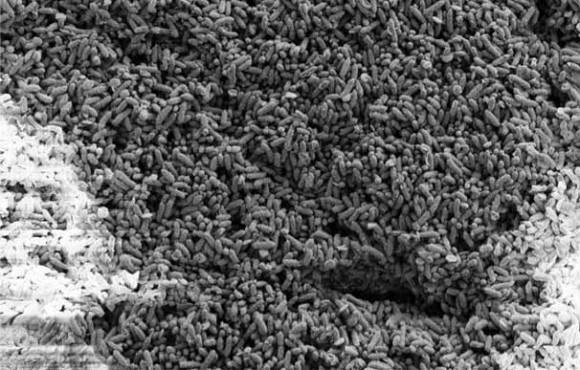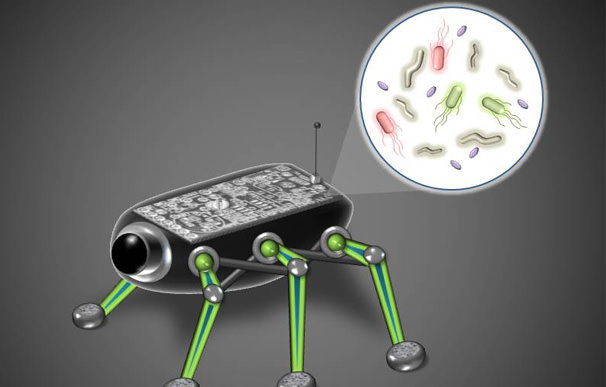[/caption]
As technology advances, a lot of the gadgets and other things we use keep getting smaller, lighter and thinner. Now that trend may soon be taken to another extreme – small robotic space explorers which in turn use a miniscule power source – bacteria.
It may sound like science fiction, or just odd even, but that is the idea behind a new proposal by NASA for an alternative to the solar and nuclear powered missions common today. The bacteria could provide a long-lived energy source which could sustain a tiny robotic probe; the amount of energy generated would also be small however, not enough to power larger probes like the Mars rovers for example. The microbial fuels cells could last a long time however, as long as the bacteria themselves had an adequate food supply.
The microbe being considered for the project is Geobacter sulfurreducens, which does not require oxygen for its survival.

A research team at the Naval Research Laboratory would like to have a working prototype of just such a robot within the next ten years that would weigh about 2 pounds (1 kilogram). There are technological hurdles, as with any new mission concept, to be overcome which will take several years.
Another major concern however, is the problem of contamination. Planetary probes, especially ones going to Mars, have been sterilized before launch according to a long-standing protocol, to minimize the introduction of earthly bacteria to the alien environments. So what would happen if a bacteria-powered probe was sent? It seems counter-productive then to deliberately send microbes which not only hitch a ride but are actually the fuel.
According to Gregory Scott at NSL: “There are planetary protection concerns, as well as concerns about protecting the microbes themselves from radiation. Sometime down the road we also have to consider whether the microbes we’re looking at are most effective for radiation environments or extreme temperatures.”
Any bacteria-based fuel system would have to take the contamination issue into account and be developed so as to try to minimize the chances of accidental leakage, especially in a place like Mars, where such organisms would have a decent chance at survival.
The concept is an innovative and exciting one, if the various technological and environmental concerns can be addressed. If so, our tiny friends may help to open a new chapter in space exploration.
Scott continues: “As we move forward in the utilisation of MFCs as an energy generation method, this research begins to lay the groundwork for low powered electronics with a long-term potential for space and robotic applications,” says Scott. Microbial fuel cells coupled with extremely low-power electronics and a low energy requirement for mobility addresses gaps in power technology applicable to all robotic systems, especially planetary robotics.”


There are a couple of problems. The bacteria have to be heated up. Mars on average is at about dry ice temperatures here on Earth. The question is then whether the bacteria can generate enough energy to both run this mini-rover and heat themselves up at the same time. The other problem is the fuel for this agar-dish bacteria “battery” is agar or some medium. Something like maltose is ultimately the fuel supply. Does running this energy through bacteria save that much in fuel or increased efficiency over solar cells or RTGs?
At least they are mentioning the contamination issue, which is good. I see that as a potential show stopper as well. These bacteria will have to be genetically modified to rely upon some molecule or amino acid from outside. Once cut off they die.
LC
There are a couple of problems. The bacteria have to be heated up. Mars on average is at about dry ice temperatures here on Earth. The question is then whether the bacteria can generate enough energy to both run this mini-rover and heat themselves up at the same time. The other problem is the fuel for this agar-dish bacteria “battery” is agar or some medium. Something like maltose is ultimately the fuel supply. Does running this energy through bacteria save that much in fuel or increased efficiency over solar cells or RTGs?
At least they are mentioning the contamination issue, which is good. I see that as a potential show stopper as well. These bacteria will have to be genetically modified to rely upon some molecule or amino acid from outside. Once cut off they die.
LC
Now hang on a minute, I’m confused. If the bacteria can’t survive in the Martian environment, then contamination isn’t an issue. And if they can, then heating them up isn’t an issue. What am I missing here?
Bacteria are not killed by cold. They may be frozen and their bio-functions stopped. If they are warmed up they come back to life. So Earth bacteria that is sufficiently hardy might life during moments of warmth in a freeze-thaw cycle. Even human sperm is frozen in liquid nitrogen at sperm banks. What small cells have to their advantage is that under freezing the crystalline ice unit is likely to be larger than the cell size, so the expansion of water is not likely to burst cells. For a large organism freezing leads to lots of water crystallization zones that rupture cells and tissues.
If you are to use bacteria as a power system you don’t want them freezing because your power system closes down.
LC
This is cool. Send out a probe to visit multiple planets, from that probe you launch these small search bots on all planets it stops at.
Most of the concerns already voiced here hit me too. Except that I am not so concerned with the likelihood of successful contamination of an existing biosphere or problems of identifying recent Earth contamination in the opposite case, so I didn’t think of a death switch.
Instead I will add that the referenced article claims “a power system that’s not reliant on … day or night cycles …”, which is also questionable. I don’t know the roots and extents of circadian molecular clocks, but IIRC prokaryotes can have them for good reasons.
I am quietly relieved that they didn’t go for the standard E. coli though, because that would seem like unnecessary crapping up the solar system!
In inter-planetary missions, the journey through space and another planet’s atmosphere through to a bumpy landing introduces many risks that could lead to a breach and contamination of the alien planet.
This surely raises both ethical practical issues – particularly in missions where the aim is to search for the signature of life.
I think it cuts both ways, what we have done and what we could do.
What have we done
—————————-
– If we look at infectious agents like prions, we can’t sterilize them efficiently.
IIRC some caustic soda washes (and recently discovered, organic enzymes of some tree fungus) can break them down, but no one has done that nor would you expect a craft to survive the treatment.
Prions may be infectous only on our types of cells, but you never know. (IIRC, bacteria have prions.) And they constitute noise for measuring organics.
– Infectious agents like viruses and bacterial spores can perhaps be autoclaved to denatured proteins states.
But no one has done that either because the crafts don’t survive it.
Viruses may be infectious only on our types of cells, but you never know. And again, they are noise for organics measurements.
– Bacteria can be heat sterilized by long baking at moderate temperatures.
The only crafts that have been subjected to that is, to my knowledge, the Vikings, packaged in their descent shells.
– When I, long ago, looked up the agreed on procedure for interplanetary crafts (unless I messed up), there is IIRC thorough wipe downs with cleaning agents to decrease bacteria and their eventual spores to a sufficiently low and measurable level. The chutes can’t be wiped obviously, and considering their area they are the most spore-bearing surfaces directly exposed to other planets.* The same problem happen inside the craft with its packed circuit boards, cables and modules.
It is then in my mind likely that every properly cleaned craft has already landed hundreds of thousands and possibly millions of potential spores on Mars. Even more for those who didn’t follow the agreement properly.
What could we do
————————–
Apparently we don’t infect Mars very quickly, either by earlier Earth impact ejecta traveling to Mars or by modern probes, or we would have noticed by now.
I think that is understandable. Spores wait for environmental triggers of decent conditions before they redevelop ordinary cells, and you won’t find those on the surface.
In addition to that, spores usually wake up randomly because it increases survival of populations even if many cells perish unnecessarily if some survive in unfamiliar environments. Even if hence a certain subpopulation eventually wake up, they are not adapted and will likely perish before they and their descendants can adapt.
If Mars is inhabited below the surface it is even worse. Sporadic earthly survivors will have efficient competition and mostly provide nutrients for already existing life.
Finally, if earth bacteria would against all likelihood survive we can easily see their recent ancestry from current earth lifeforms. They would provide some noise though, especially on organics production.
If we go back to the possibility of Earth transpermia, any fossils or survivors that come from sufficiently far back in time would have us go back to the original questions: is Mars habitable, does it have indigenous life, and in the latter case did it originate independently? These questions can become difficult to answer, at least compared to recent contamination.
In the light of all this, I don’t think small bacterial reactors make much of a difference.
———————
* This is btw a good point for Dragon. I recently lucked onto a NASA presentation on their and SpaceX preliminary design work of a Red Dragon mission to Mars on the web.
Preliminary results (in October, IIRC) was that they can land (!) but won’t be helped by a chute. So they will land on ballistic slowdown and rockets only, still landing at least 1 metric ton of payload.
One of these go in to space and the religious folk will have a field day when we eventually find life blaming it on this instead of reality. Just my extra 2 cents adding to the growing comments (which I all agree with) below.
Those determined enough to cling to their beliefs will always dismiss it as a conspiracy of some sort, regardless of what evidence is presented.
On the “bright” side, they have just invented a plausible mechanism for the “grey goo” scenario. Miniature machines that need nothing but bacteria for inexhaustible power. Since bacteria can survive in pretty much every corner of the Earth, all we have to do is come up with a way for these suckers to self-replicate and *poof* nanotech apocalypse. 🙂
directed energy transmission was a dream of Tesla’s and could be brought to bear here.
any fleet of landers will need to be supported by orbiters anyway. why not have them supply the energy too? most of our destinations of research will be sans atmosphere.
oh great, that’s all we need. turning bacteria into robots who will then go on a destructive rampage stealing old people’s medicine. this is madness i tell you…madness!
Maybe all the risks involved in the use of this technology can be avoided by replacing it with “gastrobotics”, which is related to it. Gastrobots were invented about 14 years ago and what supplies their energy is digestion (of carbohydrates, fats, alcohol or some other kind of food).
what a cool idea. i love that we’re at the point where these things can become reality. because why not? the more we eclipse what we thought impossible, the more we will think the impossible is possible.
regards,
joseph
Metairie homes for sale